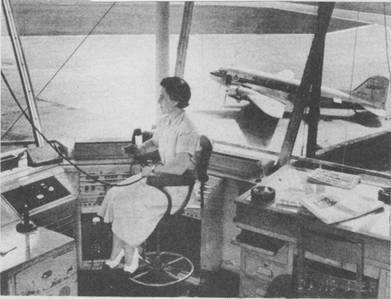
|
1952 Air Control's First lady
Frances Oneson is Canada's first woman to qualify for an Air Traffic Controller Licence. Having worked in the Montreal control tower for the last seven years as an Air Traffic Control Assistant, Miss Oneson successfully wrote the Civil Aviation examination in June, which qualifies her for more responsible duties. The Department employs seven other girls as air traffic control assistants two of whom--Margaret Dunseith and Dorothy Craw of Toronto--have since qualified for Air Traffic Controller Licences.
Born in Dorval, a stone's throw from the airport, Frances applied for the position of Air Traffic Control Assistant in 1945. Since that time she has been in the tower learning the complicated work of air traffic control.
An air traffic controller sits in the tower directing traffic in the air as a policeman directs traffic on the streets. No plane can come in for landing or take off without permission from the control tower. The traffic lanes in the sky are invisible, and when there are many planes coming in to land or take off, the pilot must know which runways to use and where to park.
The control officer on duty relays pertinent information to the pilot to enable him to know which runway to use and conditions for landing or departure, weather conditions, wind velocity and other factors of importance in air navigation. When the sky is full of planes and schedules have to be met, it is important to maintain a degree of separation in both time and space between aircraft.
The speed, load, size of the plane, weather conditions and numerous other factors must be considered by the control officer in directing an aircraft.
While the majority of aircraft are radio directed, a signal lamp is used to direct planes without such equipment.
"The job is interesting, the hours are good, and I like the work" said Frances, who has chosen to make a career of her job as a control officer.
|
|
Links - Liens
|






